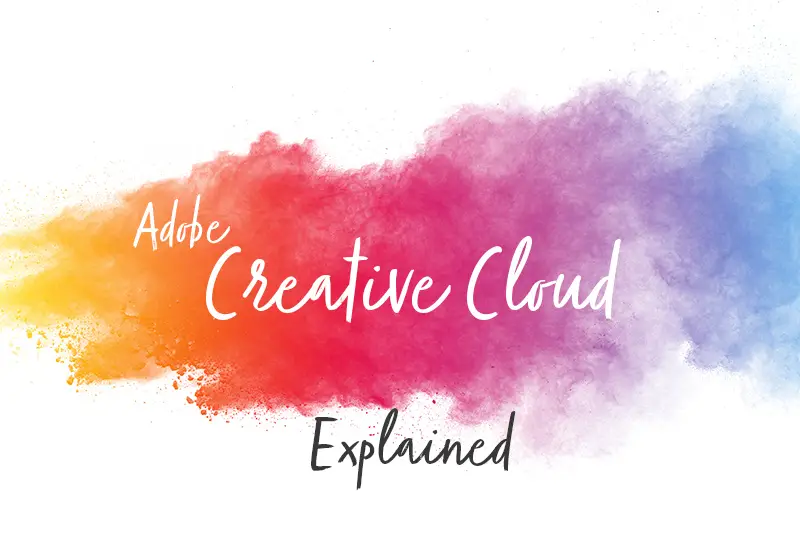Let’s face it, Adobe offer so many software apps that it can be highly confusing what each of them does and when to use them for your project. In an effort to demystify this, I will give you a rundown of each app in the Creative Cloud membership and also some of the additional web services Adobe offer. We’ll also go through the various subscription plans so you can find the one that suits you the best.
Adobe Creative Cloud membership is a collection of Adobe’s productivity apps bundled into a subscription model. It includes programs for Image Editing, Graphic Design, Video and Audio Editing, Animation, Publishing and more.
In the interests of avoiding duplication, I have grouped apps into their primary usage case but there is a large amount of overlap. For example, Adobe Photoshop software is relevant for most categories but to avoid duplication I have listed it under photography. You get the picture (excuse the pun).
For more information check out Adobe’s Creative Cloud page here (paid link).
Subscription Plans
For the purposes of this section I will be talking about the subscriptions aimed at individuals rather than the business or corporate packages that Adobe offers. Thankfully, a little less bewildering than the variety of programs, are the subscriptions. Whilst it could be simpler, Adobe offers a number of packages to give you maximum value. They also offer subscriptions to many individual apps, if you don’t want to opt for the full Creative Cloud plan. Needless to say, the info here is correct at the time of writing and may vary according to your region so check the Adobe website for the latest info.
Head over to Adobe’s site here to check out the subscription plans mentioned below (paid link).
| Subscription (Link to Adobe.com) | Apps Included |
|---|---|
| Free | Adobe Bridge (not image editing functions via Camera Raw), Adobe Aero, Creative Cloud Express (basic functions) |
| Photography (paid link) | Adobe Photoshop, Adobe Photoshop Lightroom |
| Creative Cloud “All Apps” (Does not include Substance 3D apps) (paid link) | Adobe Photoshop, Adobe Illustrator, Adobe Premier Pro, Adobe After Effects, Adobe Bridge, Adobe Audition, Adobe Media Encoder, Adobe Camera Raw, Adobe InDesign, Adobe Photoshop Lightroom, Adobe Premiere Rush, Adobe Fresco, Adobe Dimension, Adobe Dreamweaver, Adobe Animate, Adobe Character Animator, Adobe InCopy, Adobe Prelude, Creative Cloud Express (premium) and more |
| Substance 3D Collection (paid link) | Adobe Substance 3D Painter, Adobe Substance 3D Sampler, Adobe Substance 3D Designer, Adobe Substance 3D Stager |
| Substance 3D Texturing (paid link) | Adobe Substance 3D Painter, Adobe Substance 3D Sampler, Adobe Substance 3D Designer |
If you’re a student or teacher, Adobe also offer a heavily discounted “All Apps” subscription plan. See further details over at Adobe here (paid link).
Photography
Image editing, manipulation and workflow efficiencies are what you’ll be looking at if you’re a Photographer.
Adobe Photoshop
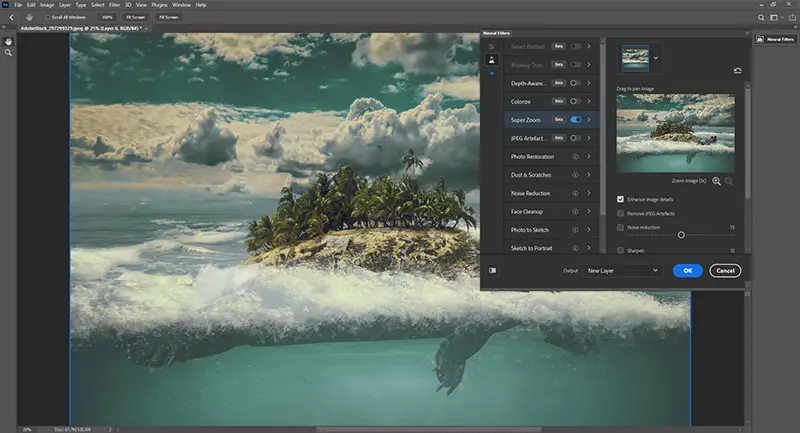
What does it do? Advanced photo and image editing, manipulation and image composition.
Who is it for? Basically everyone. Anyone that needs to create or edit raster images. Photographers, designers and artists at all competency levels.
The industry-standard application for image editing is Adobe Photoshop and Adobe’s most well-known piece of software.
Photoshop is used for traditional photo or image editing tasks such as adjusting levels, cropping, etc but also for manipulating and compositing images – inserting pixels that were not in the original image.
For an introduction to Photoshop’s essential features check out my post, Master the Basics of Photoshop with These Essential Skills.
These two main functions make it one of Adobe’s most diverse and flexible pieces of software, suitable for photographers, designers and artists alike.
Whilst Photoshop is a master at image editing, it is most well-known for its image manipulation capabilities (inserting new pixels).
Photoshop has a large array of filters for manipulating images including the newer AI-driven Neural Filters. For an explanation of these and the amazing results they can achieve, check out my post What Are Photoshop Neural Filters?
Adobe also offer a number of stand-alone mobile applications which offer some of the functions of the desktop software, broken up into multiple apps. Some of these utilize the camera hardware of a mobile device to offer additional functionality over the desktop software. Let’s take a look:
Adobe Photoshop (Mobile version)
Photoshop on mobile devices was previously restricted to cut-down versions via Photoshop Express and other apps but with advances in hardware, a much more complete version is now possible on iPad which also supports the Apple Pencil.
Adobe Photoshop Camera
Software that augments photos taken with your mobile camera, adding filters, lenses and making professional-looking photos for easily sharing on social media.
Adobe Photoshop Express
Cut-down version of Photoshop to make basic edits on the move.
Adobe Photoshop Fix
For photo retouching and sharing on social media. Fix has been discontinued as of June 2021.
Adobe Photoshop Mix
For compositing images and creating collages from multiple images. Mix has also been discontinued as of June 2021.
Adobe Photoshop Lightroom
What does it do? Photo-editing. Workflow efficiencies with batch processing.
Who is it for? Photographers or anyone needing batch editing capabilities.
Probably the most essential pieces of software for Photographers but less so for designers and artists. The main functions of Lightroom are to:
- Make image edits
- Organize assets and workflows
- Manage back-ups.
Some of these functions can be achieved with Adobe Bridge and the Camera Raw plugin without the need to use Lightroom at all.
Lightroom is not capable of adding pixels or manipulating images. For that you need Photoshop.
What is the Difference between Lightroom and Lightroom Classic?
The difference is pretty simple between Lightroom and Lightroom Classic:
Lightroom Classic is based on local storage of your images and catalogue – eg: they are on your computer; whereas Lightroom, does these things on the cloud so you can access them anywhere you have an adequate internet connection.
Other features, such as the way images are organized and edited, are the same across both versions of the software.
As a result of the local vs cloud storage, Lightroom Classic is a better solution for reviewing and processing large volumes of images since that can be done on local storage. Compare this to Lightroom, where these would have to be uploaded to the cloud first which will most likely slow your workflow.
When using Lightroom, the large benefit of your images and presets being in the cloud is that they also sync across to Lightroom Mobile, so you can edit on the move as well.
Lightroom also features powerful learning tools with interactive tutorials on example images that allow you to see, step-by-step, how an image has been edited. You can also download the presets used, to test out for yourself.
Adobe Photoshop Lightroom Mobile
Take and share professional-looking images on your mobile device using a large number of presets. Edit on the move with images and presets synced from Lightroom via the cloud.
What is the Difference between Lightroom and Photoshop?
Both applications are for editing images so it can be confusing for beginners to understand the difference between the two.
Lightroom focuses on editing existing pixels to get the best image, whereas Photoshop does this as well as adding additional pixels to manipulate or composite content that was not in the original image.
Photoshop is used by digital artists to create some truly spectacular work by compositing images with layers.
Adobe Camera Raw
What does it do? Image-editing plugin for Adobe Bridge
Who is it for? Anyone who needs to batch-process images in Adobe Bridge without having to install Photoshop or Lightroom
Camera Raw is a plugin for Adobe Bridge that allows basic photo editing akin to Photoshop or Lightroom without the need to open those applications. This is particularly useful for batch-processing within Bridge.
Graphic Design, Illustration and Publishing
Other than Photoshop, vector design, painting and layout apps are your categories here.
Adobe Illustrator
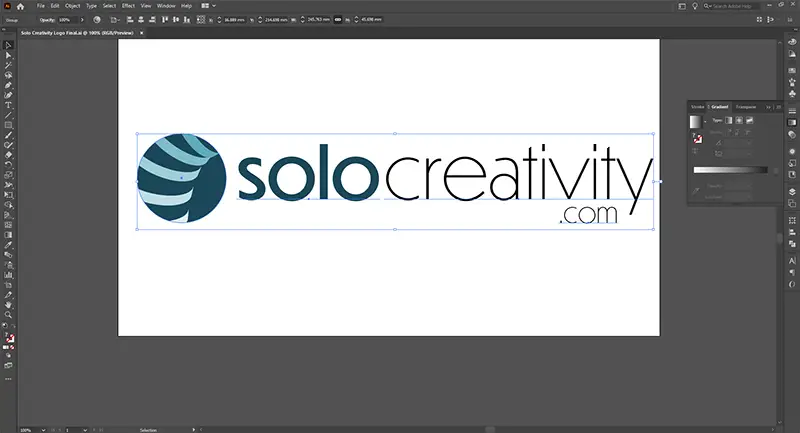
What does it do? Industry-standard advanced vector image software. Create, edit and export scalable graphics with a wide range of advanced tools.
Who is it for? Graphic designers, illustrators, anyone needing advanced vector tools.
Another industry-standard application is Adobe Illustrator. Used for vector images rather than Photoshop’s raster ones. There are a wide range of tools to support creation of images from-scratch or importing and converting raster images into vectors. The range of output settings makes it easy to generate vector or raster exports.
If you’re used to Photoshop only then Illustrator has a bit of a learning curve since it takes some adjustment to the different way of working. Not the simplest of programs but it is worth putting in the effort to learn.
Adobe Fresco
What does it do? Digital painting and drawing using stylus or touch device
Who is it for? Digital artists, illustrators
Fresco is a digital painting and drawing app, capable of working with raster or vector formats. Designed to take advantage of touch devices and styluses. Fresco uses PSD files which can easily be transferred into Photoshop for additional work such as touching up or adding text.
Fresco is free with an upgraded premium version also available.
Adobe InDesign
What does it do? Desktop publishing software for print or digital publications.
Who is it for? Print and digital publication designers.
InDesign is Adobe’s desktop publishing software for layout of digital and print publications. It is also capable of designing interactive publications.
InDesign is yet another industry-standard piece of software and is used to create some of the industry’s largest publications. It also integrates with InCopy to enable parallel working by designers and copywriters.
Adobe InCopy
What does it do? Copywriting software – use it to generate text and style it for use in publications. Integrates with InDesign.
Who is it for? Copywriters
Created to allow copywriters to simultaneously work on publishing projects with designers that are using InDesign. Allows styling of text and basic modification of layouts.
Video
Apps for all stages of your workflow and ability are offered, from professional film-making to Instagram videos.
Adobe Premier Pro
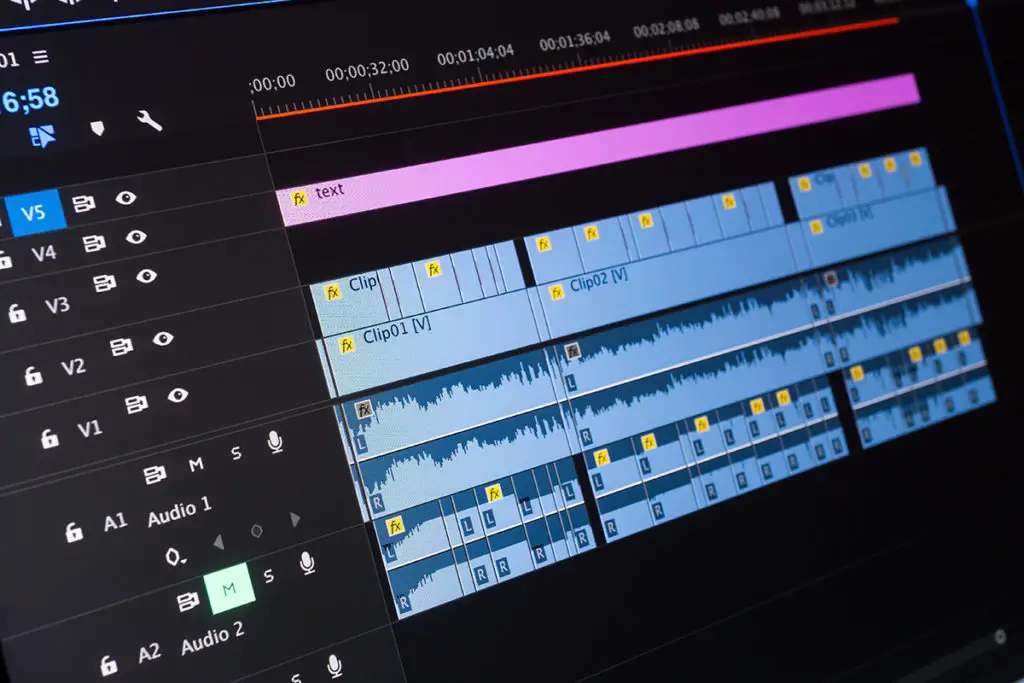
What does it do? Fully-featured video editing package for all sizes of project.
Who is it for? Video editors, film-makers, social media channels, amateur and professional.
One of the industry’s leading video editing packages for editing videos and films. In-depth features make it extremely powerful.
Adobe Premiere Rush
What does it do? All-in-one software for basic video editing, audio and graphics for sharing online. Mobile and desktop apps available.
Who is it for? Social media channels or those making basic videos
Primarily aimed at creating and sharing online videos including basic editing, adding of audio and graphics. Integration with Adobe Stock and social media. Available on desktop and mobile devices.
Adobe Prelude
What does it do? Organize and assemble raw footage into rough-cut videos for export into full video editors such as Premiere Pro.
Who is it for? Video editors, film-makers.
Created with the purpose of generating rough-cut videos from footage that can then be passed into Premiere Pro for main edits. More useful for larger projects due to its usage case. Prelude can also organize footage into bins and be used to apply meta data for easy searching.
Adobe After Effects
What does it do? Motion graphics and visual effects for export to video editing software.
Who is it for? Video editors, film-makers
After Effects is used for advanced motion graphics and visual effects which can then be imported into Premier Pro for editing into video projects. Once mastered, After Effects is capable of creating some amazing results and this short description does not do the app justice – I thoroughly recommend checking it out.
Adobe Media Encoder
What does it do? Converts audio and video files into a wide variety of formats using a queue-based system.
Who is it for? Anyone that needs to convert a lot of audio and visual files or needs a niche format.
Media Encoder is a stand-alone application for converting audio and visual files. It can also be used as a companion app from Adobe’s video, animation and audio programs.
Most file types can be selected and presets generated for reuse. The software uses a queue-based system so is particularly suitable for a large number of files. Set it and forget it.
Audio
Adobe is a bit short on the ground on audio apps but what they do offer is excellent.
Adobe Audition
What does it do? Record, edit, clean-up and add effects to audio.
Who is it for? Anyone that needs to edit audio.
Audition is Adobe’s primary audio software. It tackles recording, editing, addition of effects and cleaning up audio.
Animation
2D and 3D animation options for a variety of applications.
Adobe Animate
What does it do? Animate vector graphics, make interactive experiences.
Who is it for? Game Designers, Animators, Web Marketers, Film and TV
With Animator you can create animated vector graphics with interactive functionality. This could be characters or animation of graphics. Aimed at games creation, 2D animators, graphics for film and TV or web publishing/advertising.
Adobe Character Animator
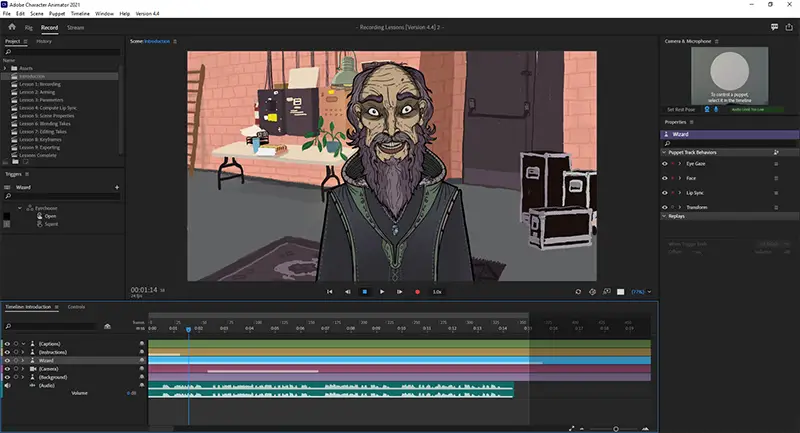
What does it do? Rig 2D puppets and animate in real time using motion capture from a camera or webcam.
Who is it for? Animators that need to create dialogue-based character animation or live stream as a character. Suitable for beginners and professionals.
Create puppets from Photoshop or Illustrator or use the built-in ones in Character Animator. Animate limbs and then assign movements to keys for use in real-time. Combine this with face-tracking and lip-syncing from audio to create facial expressions and body movements. Animations can be recorded from motion-capture performances making workflows much faster than traditional animation. It is does have a restricted purpose of dialogue-based character animation.
Mixamo
What does it do? Mixamo is not an app but an online marketplace of free 3D character models and motion capture animations.
Who is it for? Game designers, animators and film-makers.
Mixamo web platform offering downloadable 3D characters and motion-capture animations. These animations can be applied to you own 3D characters as well as the ones downloaded form Mixamo. It also features auto-rigging of models so you can upload your own and Mixamo will take care of this automatically which is incredibly useful.
UI and UX
Adobe offers a mixture of innovative software and legacy apps in this category
Adobe XD
What does it do? Design and prototype UI/UX for any type of interaction including games, apps, websites, voice and emails.
Who is it for? Anyone creating a product or service with a user interface. Great for prototyping. Available on both Windows and MacOS unlike some of the competition.
XD (Experience Designer) competes with Sketch and Figma which are the big boys in the market but is available on both Windows and MacOS unlike Sketch. XD is simple to use yet packs in powerful features and is gaining in popularity as a result. The ability to prototype, it’s responsive designs and collaborative tools make it a worthwhile tool to learn.
Adobe Dreamweaver
What does it do? Design, code and publish websites
Who is it for? Web designers
Dreamweaver has been around almost as long as the web itself as WYSIWYG (What You See Is What You Get) web development tool. Whilst indispensable back in the day, web development has moved on, so Dreamweaver is used far less nowadays.
UXP Developer Tools
What does it do? Tool for creating plugins for UXP powered applications such as Photoshop
Who is it for? Plugin developers
A tool for creating plugins for Photoshop and other programs. Not a lot more to say really but at least you now know what it’s for.
3D and AR
Some of Adobe’s newest offerings along with a stand-alone subscription to boot
Adobe Substance 3D is a pre-existing platform (formally known as just Substance) for 3D modelling and texture creation which Adobe acquired back in 2019. Substance 3D is broken up into several apps each with their own specific function in the 3D modelling workflow.
Adobe has chosen not to offer the Substance 3D Apps as part of the Creative Cloud “All Apps” subscription. Instead, they are included as part of two stand-alone subscriptions:
- Substance 3D Texturing: Painter, Sampler and Designer apps.
- Substance 3D Collection: Stager, Painter, Sampler and Designer.
Check out the Substance 3D subscriptions on Adobe.com here (paid link).
Adobe Substance 3D Stager
What does it do? Build scenes with existing 3D models, set up lights and cameras and export renders or scenes to AR.
Who is it for? 3D designers
For building 3D scenes including positioning lights and cameras. For a great overview, take a look at Adobe’s video above.
Adobe Substance 3D Designer
What does it do? Create 3D materials, models and lighting
Who is it for? 3D designers
A tool for design of 3D models, materials and lighting which is heavily used in game design.
Adobe Substance 3D Sampler
What does it do? Extracts materials from existing images and enhance or combine them
Who is it for? 3D designers
Sampler is a tool for extracting surface materials from photos that can then be used on your 3D models in Painter or Stager.
Adobe Substance 3D Painter
What does it do? Paint 3D models with textures
Who is it for? 3D designers
Substance 3D Painter is a tool for painting 3D models, which sounds pretty obvious when you think about it. The tool uses hand gestures and smart materials that adapt to the model on which they are applied.
Adobe Dimension
What does it do? Import existing 3D models, apply graphics / decals and render scenes.
Who is it for? Designers needing to create brand and product visualizations.
Dimension is included in Creative Cloud “All Apps” plan so if you don’t fancy subscribing to the Substance 3D plans then you will still have some 3D capabilities. It does have a specific usage case which is more closely aligned with Substance 3D Stager so it’s not for actually creating 3D models themselves.
The software allows importing of existing models to apply graphics such as logos, labels, etc and then creation of 3D scenes and lighting. It has useful tools for integrating with 2D background photos to maintain the same perspective and lighting.
Scenes can then be rendered and exported as 2D images or 3D interactive scenes.
Adobe Aero
What does it do? Build AR (augmented reality) scenes using assets from Adobe and third-party apps
Who is it for? 3D designers, game designers, anyone needing augmented reality scenes
Available for both mobile and desktop, Aero is made for creating Augmented Reality scenes using imported assets. It’s also free!
Asset Management
There’s only one app in this category but there only needs to be
Adobe Bridge
What does it do? Organizes assets from Adobe apps, apply meta data, batch process image editing
Who is it for? Anyone that has a significant number of assets to manage.
Primarily a digital asset manager for organization, Adobe Bridge is also capable of batch processing images with the Camera Raw plugin. Bridge has a lot of useful features for assigning meta data, batch processing and exporting and previewing assets that make it essential to an efficient creative workflow.
For more detail about Adobe bridge, check out my post What is Adobe Bridge and What Is It Used For?
Assets
Beyond the Creative Cloud apps, Adobe offers a wide variety of ways to source high-quality assets
Adobe Stock
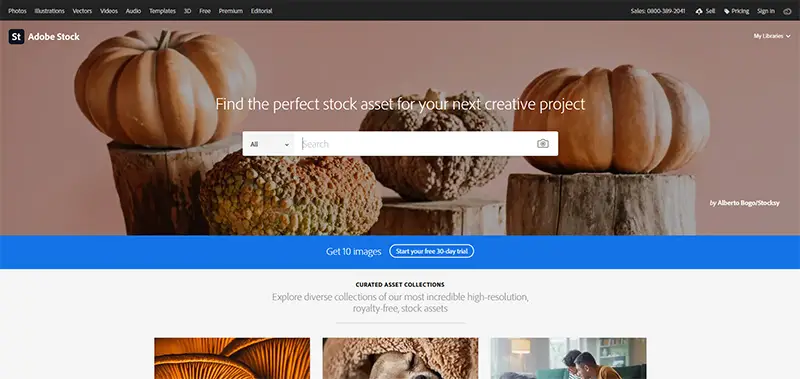
What does it do? Marketplace for free and paid images, videos, 3D models and audio assets
Who is it for? Wide variety of creatives
Not really an app but Adobe Stock has a variety of images, videos, 3D models and audio that can be purchased with credits or a subscription. There are also a number of free assets but these are comparatively restrictive in number and quality compared to the paid offerings.
Adobe Stock is integrated into many of the Creative Cloud apps, making both accessing for usage and publishing directly to the platform quick and easy.
Check out Adobe Stock’s subscription and credit plans on their site here (paid link).
Adobe Fonts
What does it do? Catalogue of fonts for use with Adobe apps. Unlimited, licensed fonts included with Creative Cloud subscriptions
Who is it for? Anyone needing quality fonts
Thousands of Fonts included with Creative Cloud subscriptions and already licensed. Just select fonts you want to download and they will automatically appear for use in your Creative Cloud apps. Integration with Adobe apps is seamless and fonts can be managed centrally through the Creative Cloud app itself.
Adobe Color
What does it do? Creates color themes based on your selection of one or several colors. Provides inspiration for harmonized colors based on color theory. Save and manage color themes in libraries and export them for use or publishing.
Who is it for? Designers working with colors. So basically all designers then.
Adobe Color makes it easy to select complimentary color palettes in a number of ways and then save them as Themes. You can use the color wheel to specify how ever many colors you want and how similar or different they should be based on rules. Give a base color and Adobe Color makes suggestions for other colors to use is your theme based on color theory.
This can be particularly useful if you are a color blind designer. For more tools like this see my post Tools for Color Blind Digital Artists.
A really useful feature is the ability to upload a reference image and let Adobe Color extract the main colors or color gradients from the image.
The output of all of these methods are colors referenced by their hex values, RGB, CYMYK, HSB or LAB. These can be saved or outputted.
Your color themes can also be checked for accessibility with a contrast check for text on backgrounds, ensuring that they are easy to read and what the minimum size should be.
Adobe Capture
What does it do? Mobile device app – use the camera to identify fonts, colors or turn photos into vector images. Literally capture visual elements from the real world and turn them into digital assets for your creations.
Who is it for? Graphic designers, illustrators
A handy multi-purpose mobile app that uses the camera for a number of benefits. Extract color themes and brushes and convert images into vector shapes. Capture can also detect fonts and suggest similar ones.
Adobe Substance 3D Assets
What does it do? Marketplace offering curated Adobe assets for usage in Substance 3D. A small number of free assets but most require one of the Substance 3D subscriptions.
Who is it for? 3D designers
Reasonably self-explanatory this one but Adobe offers a number of high-quality materials, lights and 3D models for use with its Substance apps. Access to most of these materials requires one of the stand-alone Substance subscriptions (see above) so is not included in Creative Cloud “All Apps” subscription but there are a small number of free ones as well.
Adobe Substance 3D Community Assets
substance3d.adobe.com/community-assets
What does it do? A community to share or download Substance 3D assets created by other users for free.
Who is it for? 3D designers
Free to download and upload, the Community Assets are full of high-quality user-generated materials. Perfect for those new to Substance 3D to learn the ropes.
Web
Adobe offers a number of online platforms for sharing portfolios but also creating work destined for web-consumption
Adobe Portfolio
What does it do? Create a website to showcase your work. Included in Creative Cloud “All Apps” subscriptions.
Who is it for? Photographers, Designers
A platform to create and host a webpage showcasing your best work. Add pages and select themes to create a Portfolio that fits your style. Integration with other Adobe apps such as Bridge makes it easy to add work to your portfolio. Share your link with others or optionally publish to Behance as well.
Behance
What does it do? Social media for creatives. Share your work and discover other’s creations.
Who is it for? Any creatives from architects to web designers.
Adobe’s answer to a social network for creatives for sharing a discovering work. It works, it’s world-wide and it’s huge!
Create projects, upload your assets as with Portfolio but the added social network capability makes sharing and discovering work much easier than Portfolio.
You can also support your favorite creatives with a Subscription which gives access to live-streams and source files.
Creative Cloud Express (Formally Adobe Spark)
What does it do? Create content for sharing on social media including graphics, videos and web pages. Comes in desktop and mobile flavors.
Who is it for? Social media butterflies, digital marketers
Desktop web application for quickly creating graphics, web pages and video aimed at social media, email marketing or other simple projects such as newsletters. You can also set up your brand colors, fonts and logo to make sure all you work is consistent.
Creative Cloud Express also has a mobile app for to create and share content on the move.
A free version of Creative Cloud Express includes basic features and some limited resources. The Premium paid version includes additional resources such as stock images, fonts and templates along with more editing functions and storage. The premium version is included in the Creative Cloud All Apps subscription.
Conclusion
Adobe offer so many apps as part of their Creative Cloud memberships, Substance 3D memberships, free apps and web platforms that it can be overwhelming which to use and when. Hopefully this guide has helped demystify what’s available and let you focus on the apps to use or learn for your next project. For more information check out Adobe’s Creative Cloud page here (paid link).
Even though the Creative Cloud “All Apps” plan is great value, it can still be a lot of money if you are in education. If you’re a student or teacher, Adobe offer a heavily discounted “All Apps” subscription plan. See further details over at Adobe here (paid link).
If you’ve enjoyed this guide then you might also be interested in my Essential Gear for Digital Creatives: Complete Guide.
Featured image: Pattadis / stock.adobe.com
Adobe, Adobe Aero, Adobe Animate, Adobe Audition, Adobe Bridge, Adobe Camera Raw, Adobe Capture, Adobe Color, Adobe Dimension, Adobe Fonts, Adobe Fresco, Adobe Media Encoder, Adobe Portfolio, Adobe Premiere, Adobe Premiere Rush, , Adobe Spark, Adobe Stock, Adobe XD, After Effects, Behance, Creative Cloud, Creative Cloud Express, Dreamweaver, Illustrator, InCopy, InDesign, Lightroom, Photoshop, Mixamo, Photoshop, Prelude, Substance 3D Designer, Substance 3D Painter, Substance 3D Sampler and Substance 3D Stager are either registered trademarks or trademarks of Adobe in the United States and/or other countries.

